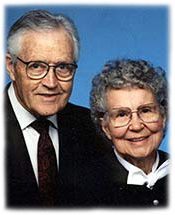Dr. Raymond Moore and Dorothy Moore (In memoriam 1915 - 2002)

Dr. Raymond S. Moore was born in Glendale, California, on September 24, 1915. At age four, Raymond lost his devoted mother, Dorcas, to the devastating 1918 flu epidemic.
Dr. Moore attended public and church schools in California. He graduated from Glendale Adventist Academy in 1932, and spent six years at Pacific Union College. His studies were interrupted by a flood that destroyed both his home and his construction business. To persevere through the Great Depression, he worked as a handyman by logging, milking cows, firing boilers, plumbing, and concrete finishing.
Dr. Moore's first teaching experience was in 1933, when he taught remedial English at Pacific Union College during his sophomore year. He graduated and married Dorothy Lucille Nelson in June 1938.
Dorothy Lucille Nelson Moore was born on a farm in Bruce, South Dakota on October 30, 1915. She was a Methodist and Seventh-day Adventist Christian of Norwegian ancestry. She helped her father at his dairy in California almost until she finished at Long Beach California Junior College and went on to Pacific Union College.
Dorothy was California State Spelling Champion and Gregg Shorthand gold medalist. In college she admired Ellen White and became a respected student leader whose first concern was poor or troubled girls.
After graduation and marriage, Dr. Moore pursued a masters degree at the University of Southern California. He taught for two years in the public schools of Artesia, California, and was principal in Hermosa Beach, California from 1940 to 1941. On May 7, 1941, he was called to active duty in the U.S. Army as a second lieutenant medical administrative officer with the Ninth Corps Area Headquarters in San Francisco, California.
Pearl Harbor resulted in a transfer to San Francisco Port of Embarkation Medical Section, where as a Captain over personnel and intelligence matters he worked in the company of a communications officer named Ronald Reagan.
His next assignment was in New Guinea, where he helped build the 47th General Hospital. He subsequently commanded the New Guinea rotation Detachment and Casual Camp, Milne Bay, New Guinea, then was promoted to Major and executive officer in the South Pacific Medical Commander in Lae, New Guinea. He concluded his 58 months of active duty by serving as general staff medical personnel officer for General Douglas MacArthur, the famed home-educated military leader, in Manila, Philippines.
After leaving active duty in March, 1946, Dr. Moore became Superintendent of Schools in Artesia, California. There he was invited to teach at University of Southern California on a doctoral fellowship. After doctoral study in college and university administration and early childhood education, he was called to Pacific Union College in 1947 as head of its graduate teacher-education program. He helped Pacific Union College upgrade and obtain state accreditation.
Dorothy, meanwhile, distinguished herself in public service in California schools as a remedial reading specialist and as a faculty wife at the University of Southern California. She then became a faculty wife and Sabbath School leader at Pacific Union College. Along with her other responsibilities, she reared and educated seven "chosen" teenagers through college.
In 1951 Dorothy moved to Japan with Dr. Moore, only a few years after her husband and brother had fought in the War to defeat Japan. The Moores helped San-Iku Gakuin College achieve status as an accredited, debt-free, senior education institution. The Moores also helped develop an Adventist school system for Japan and Okinawa. They implemented a "work-study-service" plan at the college in which all teachers worked with students, including the family of Senior Prince Takamatsu.
In 1956, Dr. Moore went to Philippine Union College. He later went on to serve as President of Southwestern Union College. His program theme continued to be work-study, debt-freedom, academic standards, social standards, and home education. Dr. Moore also worked to achieve integration of African-American into Southwestern Union College.
Dr. Moore was subsequently called to the General Conference of Seventh-day Adventists as one of a team of five to help pioneer what is now known as Andrews University in Berrien Springs, Michigan. In 1960, he went to Loma Linda as corporate vice-president to share leadership in the transition to Loma Linda University. After a years of raising a family in Japan, the Philippines and Washington, D.C., Dorothy became the founding director of the Loma Linda University Cerebral Palsy Clinic in California.
In 1964, Dr. Moore accepted the job of graduate programs officer with the U.S. Department of Education, a position which involved the funding and upgrading of master and doctoral programs of American colleges and universities. He helped colleges and universities save billions of dollars. The White House published two of his books.
After moving on to a stint with UNESCO, Dr. Moore he was invited to be the founding director of the International Advanced Intercultural Study Center. This consortium at the University of Chicago included member institutions such as Johns Hopkins, Southern Illinois, Stanford, Tulane and Wisconsin. The Center studied indigenous people ranging from Native Americans to tribes in Lesotho. Dr. Moore met the prime minister of Lesotho, along with Ghandi's former secretary and the author of Indonesia's new language.
Dr. Raymond and Dorothy Moore worked about 40 years together as leaders, editors, and authors for their research foundations. They helped form the Cedar Springs Foundation, which was later renamed the Hewitt Research Foundation. Since 1983 the Foundation has operated in Washougal, Washington, near the Columbia River. The Moores focused on early childhood education, school entrance age, and teacher-student work-study programs. Along with Raymond, Dorothy served as a pioneer in the resurgence of the old-fashioned home-education phenomenon. Reflects Dr. Moore, "God, with the likes of Reader's Digest, James Dobson, John Holt, Reed Benson, thousands of media, and all of you, turned home education into a giant movement."
The Moores have written numerous books and published articles. Their most famous work, a 1979 Brigham Young University Press book entitled School Can Wait, was written during this period. This book is a classic must-read for scholars of the alternative-education movement. Raymond's authorship credits include thirty-five college texts.

Beginning in 1983, Dorothy headed a team of carefully selected educational counselors who fulfilled the dream of helping families educate their own children legally. The Moores set up individualized programs for each child enrolled, creating units of study tailored to the child's interests, aptitudes and abilities. Now known as the Raymond S. and Dorothy N. Moore Foundation in Washougal, Washington, their program works with hundreds of families every year and has formed the basis for a "Malachi Movement" stressing family togetherness and work-study-service balance in schools. The goal of the organization is to make schools, churches and families more creative, efficient and debt-free in health, education, welfare and service to their communities.
When Dorothy passed away in 2002, after a lifetime of service, alternative educators around the world lauded her contribution. We knew her voice could never be fully replaced. "I thank God, my Master Teacher," said Dr. Moore, "for giving me a special lady for 64 years who walked at my side during half of those homeschool years through sunshine and storm."
Raymond continues to be a tireless, progressive force in alternative education. His profound reservoir of professional, cultural, religious, educational, and intellectual experience continues to inform and enrich the alternative-education movement.
For all of this, and more (no pun intended), the Quaqua Society is very pleased to present the 2002 Quaqua Elijah Award to honor Dr. Raymond and Dorothy N. Moore.
